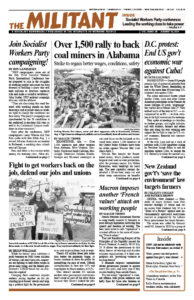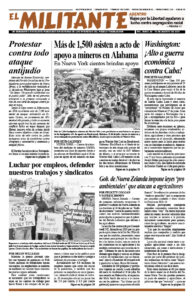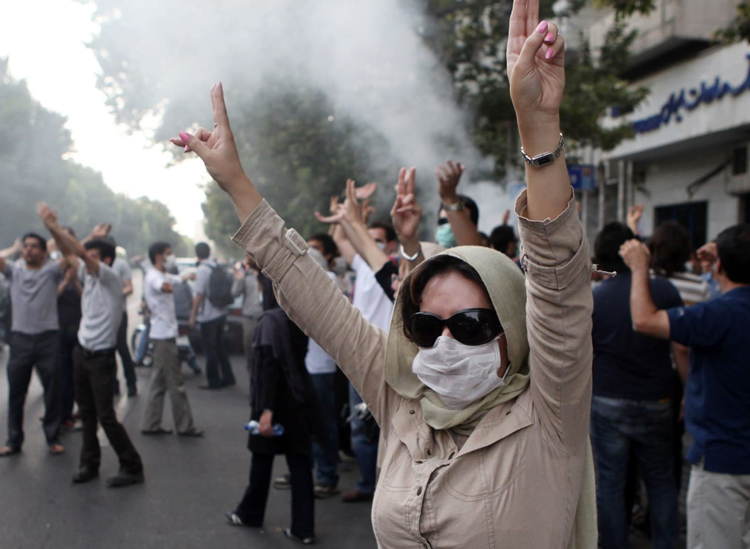Protests against Iran’s bourgeois-clerical regime spread from Khuzestan province, home to the country’s Arab minority, to cities and towns elsewhere in mid-July. Triggered by severe water shortages and power outages that hit hard on working people, demonstrators protested the Iranian rulers’ expansionist foreign policy.
For decades working people in Iran have borne the deadly human and financial costs of military assaults carried out by the regime in Tehran and its allied forces, including Hezbollah in Lebanon and pro-Tehran militias in Iraq, Syria and Yemen.
The Iranian rulers have extended their military and political influence across the region and provided military assistance to Hamas, the reactionary ruling party in Gaza, during the 4,000 rocket attacks Hamas unleashed on Israel in May.
But Tehran’s military adventures have been met with protests by working people at home over the past four years, including actions of hundreds of thousands in late 2019.
In July protesters chanted, “Neither for Gaza nor Lebanon, I sacrifice my life only for Iran!” and “Cannons, tanks, fireworks, mullahs must go!”
Despite a crackdown by security forces, the protests were the most widespread in 18 months. Hundreds took to streets July 26 in several areas of Tehran, the capital.
Protests against water shortages began in Khuzestan, in southwest Iran, where the majority Arab population has faced discrimination from Iran’s rulers over decades.
The province used to have ample water resources but the government redirected river flows elsewhere. This, coupled with Iran’s worst drought in 50 years, has caused severe shortages. The province’s dams are only half full. Over 700 villages are now dependent on trucks delivering potable water.
Livestock are dying. In an area with high unemployment and a shortage of government services, the livelihoods of townspeople and farmers have been devastated. And this is a region where 80% of the country’s oil and 60% of its gas supplies are located.
Weeks of electrical blackouts there and around the country come on top of an ongoing economic crisis, exacerbated by Washington’s financial and trade sanctions. The value of the Iranian rial has crashed, causing inflation to soar to 50% annually. Repeated surges in infections during the COVID pandemic have added to this crisis.
Protests were organized in Saqqez in Iranian Kurdistan; Aligudarz and Kermanshah in neighboring provinces; Isfahan in the center of the country; Bojnourd, Khorasan, a northeastern province; and Mahshahr, a center for the petrochemical industry on the Arab-Persian Gulf. People in Bojnourd chanted July 24, “Don’t be afraid, we all stand together.”
In Karaj, an industrial city near Tehran, demonstrators chanted, “From Karaj to Khuzestan, unity, unity!” This echoed the calls of protesters in Tabriz, Azerbaijan, in northwestern Iran two days earlier. They shouted, “Azerbaijan is awake, supports Khuzestan!” and “Azerbaijan, Al Ahvaz, unity, unity!” in Turkish. Al Ahvaz refers to the Arab nationality in Iran. Azerbaijanis in Iran have also faced national oppression from successive capitalist regimes.
Security forces used tear gas and live fire against demonstrators in a number of cities, killing at least nine protesters. The regime tries to hide its brutality by claiming unknown “rioters” fired the shots. It shut down the internet and arrested at least 171 people.
The protests follow the June 18 elections with the lowest voter turnout since presidential elections began in 1980, reflecting growing distrust in the regime. Ebrahim Raisi was elected after the country’s Guardian Council disqualified most of his opponents.
Both Raisi, a conservative, and his predecessor, Hassan Rouhani, a reformist, are part of a regime that carried out a counterrevolution in the early 1980s, aimed at consolidating capitalist rule and stifling struggles of working people that erupted in 1979 bringing down the U.S.-backed shah of Iran and beginning a popular social revolution.
Commentators on the left and right of U.S. politics present the reactionary regime today as a product of those massive mobilizations. The opposite is the case.
Gaining confidence in their own capacities during the 1979 revolution, workers established councils to advance their broad social and political interests. Farmers waged struggles for land, and women and oppressed nationalities fought for their rights.
The cleric-led regime sought to suppress these struggles and carried through a counterrevolution, which they continue to extend abroad through military intervention.


